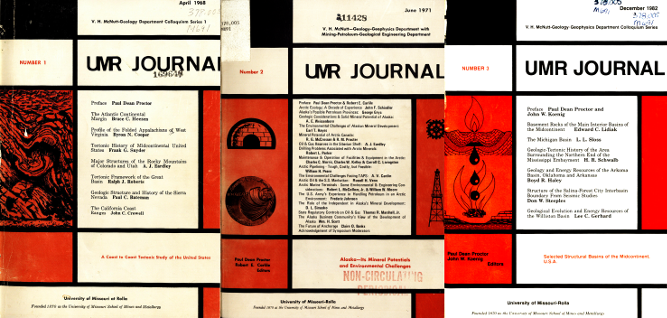UMR Journal -- V. H. McNutt Colloquium Series

Publication Date
01 Jun 1971
Abstract
Because this university, formerly under the well known title of Missouri School of Mines and Metallurgy, has contributed so much to the nation’s and world’s mineral supplies through the work of its well trained graduates, it was considered appropriate that a major symposium be held during its Centennial Year on one of the last major mineral frontiers of the United States......Alaska.
Preliminary planning for the symposium on “Alaska, Its Mineral Potentials and Environmental Challenges” began in the fall of 1969. In January, 1970, Robert E. Carlile and Paul Dean Proctor visited Alaska to meet with some of the petroleum and mineral industry personnel. The purpose of the journey was to personally invite some of the experts who could directly relate to this Centennial Symposium. The warm hospitality, graciousness, and suggestions of industry and government leaders gave much impetus to the finalization of the program and the plans.
Formal invitations were extended to various individuals who had in-depth experience in Alaska or direct interest in the Arctic areas to participate in this Centennial Symposium. Objectives were to give platform presentation and audience discussion to important aspects of the petroleum-solid mineral potential of this frontier state of America and the adjacent arctic lands and continental shelf. Because of the unusual climatic setting other speakers were invited to discuss the challenges of this environment in discovering, recovering, and transporting the potential mineral wealth of Alaska. The state consists mainly of public domain and state lands, hence other speakers were invited to present the government’s views on oil and gas developments on these lands and the Alaskan business communities viewpoint on the possible future progress of Alaska.
Special recognition has been given the various authors of the papers, but exceptional efforts were extended by the moderators who so ably assisted in the symposium presentation. Short biographical and alphabetically listed sketches are included for each of the external moderators with our sincere thanks for their considerable help. Similar concise biographical information on each of the authors is included at the end of each of the papers.
The paper presentations includes an introductory paper on Arctic Ecology, by Dr. John Schindler, Assistant Director of the Naval Research Laboratory, Point Barrow, Alaska. Regrettably, Dr. Max Brewer, Director, Naval Research Laboratory was unable to include his presentation on “What We Should Know About the Arctic Environment”. Following the ecological paper, George Gryc and A1 Weissenborn of the U.S. Geological Survey present data on the energy fuels and solid mineral potentials of Alaska. Dr. Earl Hayes, Chief Scientist of the U.S. Bureau of Mines then relates to the environmental challenges of Alaskan mineral resources. Co-authors, Drs. R. G. McCrossan and R. Procter, of the Canadian Geological Survey, review the mineral potential of Arctic Canada. Dr. A. J. Eardley’s paper on Oil and Gas Reserves in the Siberian Shelf extends the prognostications on the Arctic basin. The latter author specifically asked that it be indicated he was substituting for Russian authors who had been invited but could not attend.
With the good potential for petroleum which exists, consideration was then given to physical exploration by drilling and to the unique problems encountered in the handling of equipment under the rigorous arctic conditions. Robert L. Parker, President of the Parker Drilling Company discusses problems in such an environment. Charles C7 Norris of William Brothers Engineering Company describes the maintenance and operation of facilities and equipment in the Arctic. William Pearn discusses details of “Pipeline Design for Arctic and Subarctic Regions”, and A. V. Cardin, Chief Engineer, TAPS, specifically relates to the environmental challenges facing construction of TAPS. Russell Venn, Vice President, Humble Oil Company, expertly discussed details of the epic voyage of the S. S. Manhattan through the Northwest passage. With the possibility that oil might be transported by ship or submarine from northern Alaska, Robert L. McCollom and William Moore present interesting views on arctic marine terminals and their environmental and engineering considerations.
The practicalities and experience of handling petroleum products under conditions varying from arctic conditions to almost temperate conditions and some of the problems related to pipeline construction and pumping of oil products is dynamically presented by Colonel Frederic Johnson, Chief, Petroleum Supply, U.S. Army. Don Simasko gives his views on the place of the independent operator in this developing region with its attendent problems. Thomas R. Marshall, representing the State of Alaska, succinctly and expertly discusses the regulatory controls on oil and gas in the state.
Mr. W. H. Scott, President of the Alaskan Chamber of Commerce, concisely describes the Alaskan business communities view on the petroleum mineral resource development of his state. The final paper, by C. O. Banks, representing the Anchorage Chamber of Commerce, spells out the optimism of the good people of a great state as it moves into its stride in the 20th century.
These thoughts, views and warnings on “Alaska - Its Mineral Potentials - Its Environmental Challenges” are, therefore, presented in the hope that the reader will gain a deeper appreciation and awareness of Alaska - truly one of the last frontiers of today where, most appropriately, the words of J. Robert Oppenheimer apply:
“Both the man of science and the man of action live always at the edge of mystery, surrounded by it.”
Paul Dean Proctor
R. E. Carlile
Document Version
Final Version
File Type
text
Language(s)
English
Rights
© 1971 University of Missouri--Rolla, All rights reserved.
First Page
3
Last Page
4
Recommended Citation
Proctor, Paul Dean and Carlile, Robert E.
(1971)
"Preface,"
UMR Journal -- V. H. McNutt Colloquium Series: Vol. 2, Article 2.
Available at:
https://scholarsmine.mst.edu/umr-journal/vol2/iss1/2
Included in
Geology Commons, Geophysics and Seismology Commons, Mining Engineering Commons, Petroleum Engineering Commons


